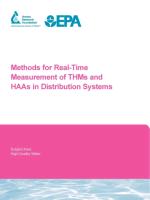Methods for Real-Time Measurement of Thms and Haas in Distribution Systems
BücherAngebote / Angebote:
Chlorination is the most widely used water disinfection process in the United States. Chlorine, typically applied as gaseous chlorine, sodium hypochlorite, or calcium hypochlorite is a safe and economical water disinfectant. Chlorination has been used with great success in the water industry for over a century. Unfortunately, water chlorination results in the formation of halogenated disinfection by-products (DBPs). These DBPs include the trihalomethanes (THMs) and haloacetic acids (HAAs).
The possibility of adverse health effects of THMs and HAAs has led to the establishment of maximum contaminant levels (MCLs) in drinking water. The THMs include chloroform, bromodichloromethane, dibromochloromethane and bromoform. The current MCL for total THMs in drinking water is 0.080 mg/L. The five HAAs that are commonly monitored include monochloroacetic acid, dichloroacetic acid, trichloroacetic acid, monobromoacetic acid and dibromoacetic acid and are referred to as HAA5. The current MCL addresses HAA5 and is set at 0.060 mg/L for total concentration of HAA5.
Stage Two of the Disinfectant and Disinfection By-Product Rule may lower the MCL for total THMs and HAAs in the near future. This will require many plant operators in water utilities to develop new strategies for minimizing total THMs and total HAAs concentrations in drinking water. They might also look toward optimizing their removal processes. To accomplish these goals, analytical methods are needed that will provide monitoring data in real-time or near-real time. The development of such measurement methods for on-line monitoring will improve understanding of variations in THM and HAA concentrations in treatment plants and drinking water distribution systems. The monitoring data will increase understanding of how peak THM and HAA formation events occur (and when they do not occur). This allows operators to adjust treatment processes accordingly at the plant and in the distribution system. Finally, the data that such monitoring provides can be used to develop better models of the water distribution system.
Folgt in ca. 15 Arbeitstagen




